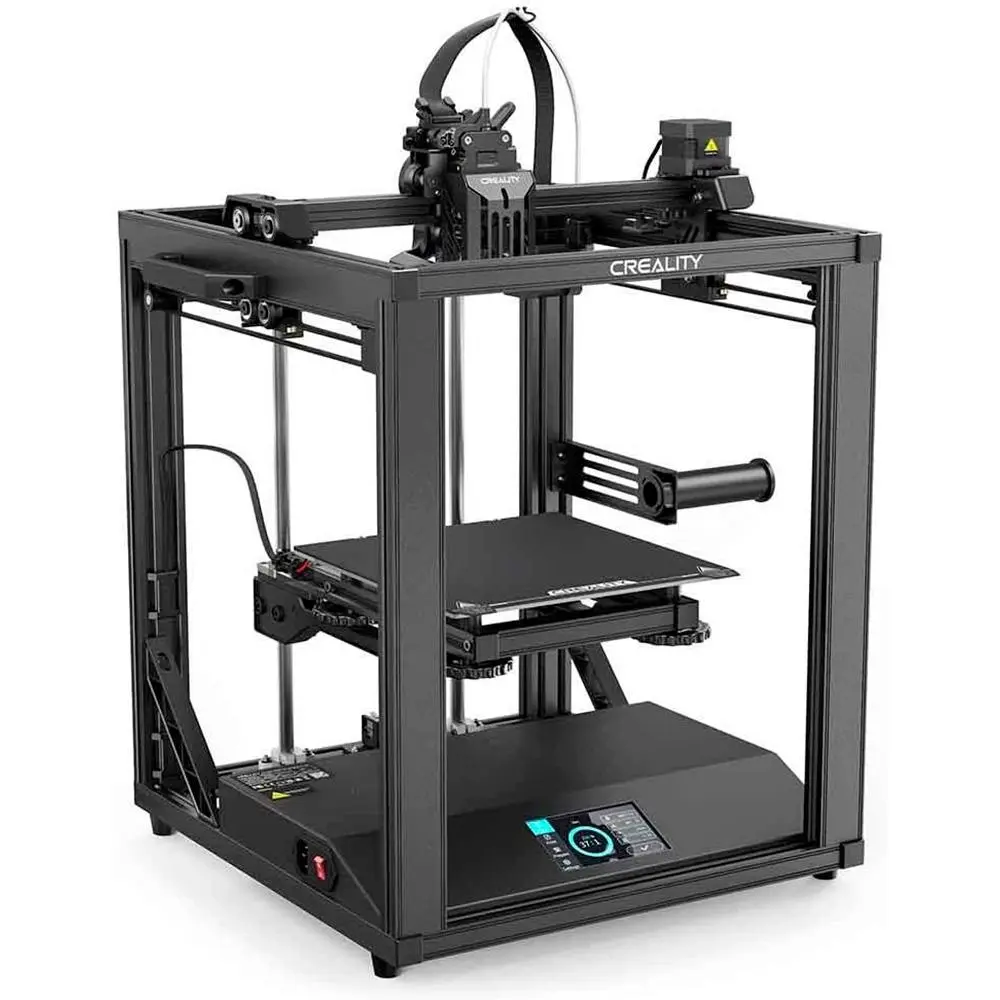Compare H2D vs Ender 5 S1
Comparison between the best 3D printers
Choose the best 3D printer at the best price. The cheapest 3D printers are here.
Buy a 3D printer here with 3D Fila.
 |
 |
|
| Model | H2D |
Ender 5 S1 |
| Printing Material | Filament | Filament |
| Buy Filament for Bambu Lab H2D | Buy Filament forCreality 3D Ender 5 S1 | |
| Estimated price | $1899,00 | $467,00 |
| Manufacturer | Bambu Lab | Creality 3D |
| Release Year | 2025 | 2022 |
| Print Volume [mm] | 350x320x325 | 220x220x280 |
| Printer Size [mm] | 492x514x626 | 425x460x570 |
| Weight [kg] | 42,3 | 12,1 |
| Power Loss Recovery | YES | YES |
| Enclosed printer | YES | NO |
| Bed Leveling | Automatic | Automatic |
| Filament End Sensor | YES | YES |
| Bed type | Heated | Heated |
| Power supply system | Direct Drive | Direct Drive |
| Standard nozzle | 0,4 | 0,4 |
| Maximum Nozzle Temperature [°C] | 350 | 300 |
| Maximum Bed Temperature [°C] | 120 | 110 |
| Maximum printing speed [mm/s] | 600 | 250 |
| Filament holder | YES | YES |
| Camera for supervision | YES | YES |
| Recommended filaments | PLA, PETG, ABS, ASA, TPU, PVA, Nylon (PA) | PLA, ABS, PETG, TPU, PC, ASA, HIPS |
| Recommended slicers | Bambu Studio | Cura, Simplify, Slic3r, IdeaMaker |
| Maximum Resolution [mm] | 0,01 | 0,05 |
| Processor | 32 Bits | |
| Display | Touchscreen 5'' | Display touchscreen 4,3 '' |
| Power Supply | 350 W | |
| Connectivity | Wifi, Bambu bus, Cartão SD | SD / USB / Wi-Fi |
| Operating systems | Windows, Mac, Linux | Windows, Mac, Linux |
| Date of registration in the system | 2025-03-31 | 2023-10-04 |
| Release date | 2025 | 2022 |
| Extra features | Bambu Labs H2D combines high-speed 3D printing with a chamber heated up to 65 °C, dual extrusion with automatic nozzle switching, an AMS for filament drying and exchange, and AI sensors that detect failures. It offers optional laser and digital cutting capabilities, features intelligent calibration through computer vision, vibration control, enhanced fire safety, and real-time camera monitoring. | A steel drive shaft synchronizes the two Y-axis belts. High-torque 42-48 Y-axis motor for responsive and precise movement. Cartesian structure. Enhanced stability by thick linear shafts, extra stiffeners, two cantilevers, and silicone bumpers. Double Die Spring profile reinforcement. Silicone bed support. All-metal Sprite direct extruder. Best for printing with flexible filaments like TPU. Auto-calibration with 16-point CR Touch. Compatible with Sonic Pad, Wifi Box, and Camera kit. |
| Support for multiple colors and materials (AMS and CFS) | YES | NO |
Notes * |
||
| Cost-benefit | 7 / 10 | 7 / 10 |
| Hardware | 7.2 / 10 | 2.4 / 10 |
| Tela | . | . |
| Print volume | 4 / 10 | 3 / 10 |
| Performance | 5 / 10 | 2 / 10 |
Conclusion |
| In comparing the Bambu Lab H2D and the Creality 3D Ender 5 S1, several factors stand out that can guide potential buyers in making an informed decision. The Bambu Lab H2D, being a more advanced model, boasts a larger print volume, faster maximum printing speeds, and higher resolution capabilities. Its enclosed design and additional features such as AI sensors for failure detection, dual extrusion, and integrated camera supervision provide a modern and robust printing experience. Moreover, it supports multiple materials and colors, making it versatile for complex projects. Conversely, the Ender 5 S1, while significantly more budget-friendly, is equipped with essential features suited for hobbyists and beginners. It offers automatic bed leveling and reliable print quality, but lacks the advanced functionalities, print volume, and speed of the H2D. In conclusion, if budget constraints are a primary consideration, the Ender 5 S1 provides a good entry-level alternative, especially for users focused on simpler printing tasks. However, for those willing to invest more for enhanced capabilities and performance, the H2D presents a cutting-edge solution tailored for advanced projects. Ultimately, the choice between the two will depend on individual user needs, complexity of projects, and budgetary limitations. |

